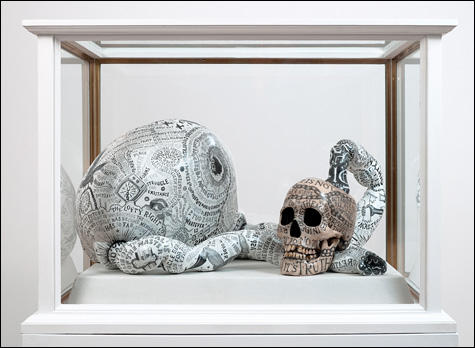
‘WHATEVER IS CONSCIOUS WEARS OUT’ Mixed-media by Dominic McGill, 2010 (front view). |
Disasters are innately mysterious. They are never pleasant, but nonetheless almost always compelling. And despite a human tendency to give them maximum exposure, they often tend to be covered up, brushed aside, or wrongfully attributed. People have forged entire industries devoted to obscuring culpability and softening the public perception of oil spills, nuclear meltdowns, and political insurrections. All of this makes disasters an uncomfortable subject in most arenas, but a perfectly suitable one for visual art, where mystery and cognitive dissonance are generally desirable. It's often the precise practice of the artist to poke holes in the shroud surrounding the logic of disaster, shedding light (or failing that, levity) on typically shadowy or contentious issues.
The stage is set then for "Drawn to Disaster," the group exhibition of international artists exploring global and personal crises through mixed-media art forms, and the Institute of Contemporary Art at Maine College of Art deserves applause for assembling such a complex, conceptually grim show during the middle of the tourist season. The exhibit will reward your attentions and stoke the impulse to investigate, even if not all of its works are successful at bringing their subjects the clarity and perspective they require.
The broad spectrum of interpretations offered by the 11 artists here make for a dynamic of disaster. Not all of the pieces deal with political or cultural events; probably not by coincidence, the best ones do. Carlos Motta's "A Brief History of U.S. Interventions" is an excellent example. For this mural installation, the Colombian-born Motta has written dozens of military interventions in columns of chalk on a large rectangular surface of chalkboard paint. A cache containing an eraser and set of chalk is mounted to the side of the mural, with instructions for the viewer to add to or revise the list, aiming for what Motta terms a "definitive version of history." Messages written in different colored chalk have been added between the original text (e.g., Soviet aggression, human nature, and go vegan), and (supposedly hours before my visit) someone obscured a good chunk of the late 20th century with an enormous missile labeled "Big Boy," possibly referencing the only nuclear weapons ever deployed in combat. As Motta indicates by his use of classroom materials, this is stuff we were never taught in schools, but it's the interactive element that prevents the piece from reading as mere anti-nationalist sermonizing. Instead, it stands as both a tablet of ulterior history and an engaging public forum.
Stacy Howe's "Sturm und Drang," a large mixed-media collage of drawings on paper, borrows images from the vast library of human calamity to create a playpen of known horrors. Howe has a terrific line and shade, lending her images a surrealistic vivacity while existing just below the surface of immediate recognition, but I would have liked to see more of a contiguous thread for her vocabulary of images. Other works exploring subconscious woe fare worse. Christian Holsted's method of drawing haunted, unparsable scenes over photos from newspapers is a unique gambit, but his two pieces are just too opaque for this show. And the anemic landscape collage of "Switchyard," purportedly a comment on Cold War fallout shelters and missile silos by noted New York artist Lisi Raskin, fails both to entice viewers into the space (it's a drab, sparsely detailed selection for the window gallery) or provide any perceptible context for its subject, instead appearing as a sort of storybook haunted forest.